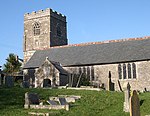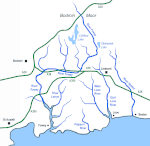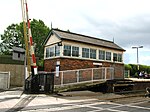St Winnow
Civil parishes in CornwallVillages in Cornwall

St Winnow (Cornish: Sen Gwynnek) is a civil parish in Cornwall, England, United Kingdom. Its name may be connected with either that of Saint Winnoc or Saint Winwaloe. It has a population of 304, which had increased to 328 at the 2011 census. The church town is on the east bank of the River Fowey south of Lostwithiel. Part of the village of Lerryn lies within the parish as does the Chapel of St Nectan. The Redlake Meadows & Hoggs Moor, a Site of Special Scientific Interest is also in the parish.
Excerpt from the Wikipedia article St Winnow (License: CC BY-SA 3.0, Authors, Images).St Winnow
Geographical coordinates (GPS) Address Nearby Places Show on map
Geographical coordinates (GPS)
| Latitude | Longitude |
|---|---|
| N 50.383 ° | E -4.652 ° |
Address
PL22 0LF , St. Winnow
England, United Kingdom
Open on Google Maps






